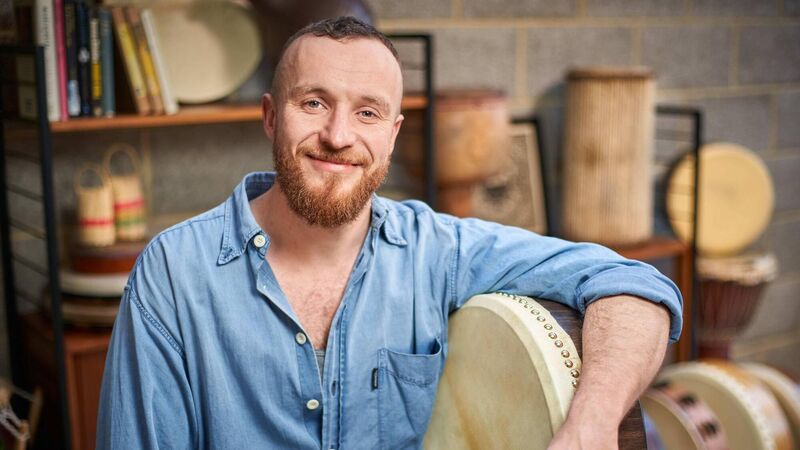Cork man beats a drum for the fascinating history of the bodhrán

Ruairi Glasheen from Cork digs deep on the history of the bodhrán.
When percussionist and filmmaker Ruairí Glasheen delves into the history and origins of the bodhrán in his new four-part documentary about the drum often hailed as the heartbeat of Irish music, what he reveals to viewers is the instrument’s surprising modernity.
“So Seán Ó Riada took what was then called the tambourine in Ireland and he changed the name to the bodhrán: up until that point, we think, the bodhrán was a skin tray for carrying things, storing things and serving up potatoes,” Glasheen explains.
“We know that object existed at the turn of the 20th century, and it’s also very possible that it was used for drumming in Wren Day rituals for one day of the year, the 26th of December. But it was Seán Ó Riada who took that instrument, included it in Ceoltóirí Chualann, played it himself and called it the bodhrán.”
It was 1960 when Ó Riada formed Ceoltóirí Chualann, a kind of precursor to The Chieftains, in part out of the necessity to find a music authentic enough for a play by Listowel playwright Bryan MacMahon. Ó Riada was influenced by existing drumming traditions of West Limerick and North Kerry, where another Listowel man, John B Keane, was also instrumental in popularising the drum: he’d go on to write a book called The Bodhrán Makers.
But until Ó Riada’s adoption of the instrument, according to flute player and music historian Fintan Vallely, interviewed in Glasheen’s documentary, the Kerry players would have referred to their drum as a tambourine and would have played it with their hand, rather than the stick or tipper that would dominate later playing.
Ceoltóirí Chualann was in part what gave rise to the enormous revival of Irish traditional music from the 1970s onwards, and the international success of acts like The Chieftains, The Dubliners and The Clancy Brothers, all of whom increased the visibility and popularity of a drum often presumed to be ancient in origin.

For Glasheen, though, things may not be this simple. Despite Ó Riada’s undisputed role in reimagining and popularising the drum, Glasheen’s films also provide tantalising glimpses of a longer tradition: a film made in 1946 by folklorist Caoimhín Ó Danachair in Athea, Co Limerick, shows a young boy using a tipper to play an upright frame drum in a manner reminiscent of modern bodhrán playing.
There are very old Scandinavian frame drumming traditions, and the Crowdy-crawn of Cornwall, an adapted sieve used in music dating at least to the 1880s.
In 1928, an early recording made in New York is credited to a John Reynolds on the “tambourine” and Tom Morrison on the flute, but, to Glasheen’s ears, resonates strongly with the performance practice of the bodhrán today.
Cork painter Daniel Maclise (1806-1870) made a painting called Snap-Apple Night, painted in 1833 and likely depicting a party held in Blarney the previous Halloween, that is credited as being the first ever painting of a bodhrán, but his version has the jingles – metal discs – that we associate with tambourines.
Of course, the devastation of the Great Famine, most especially in the West of Ireland, casts a pall over so much historical and cultural continuity, Glasheen points out.
“Everything within this story has to be delivered with a caveat because it’s very hard pre-1959 to pin down concrete details,” he says. “There are frame drumming traditions around the world that go back at least 2,000 years and the bodhrán will have somehow morphed from those, but the bodhrán as we know it today is a new instrument.”
To Glasheen, who grew up in Cork and studied drums and orchestral percussion in Cork School of Music before moving to London where he is now based, the modernity of the bodhrán in no way dilutes its Irishness or its uniqueness.
“There’s something about holding it under the arm, next to the heart: it’s intimate like a hug or a cradling,” he says. “I play a lot of different percussion instruments but there is something very special about that connection. It is an Irish drum and I will argue that even if it is quite new, it is indigenous ,and it is unique to this place.”
Glasheen’s fascinating four-part documentary series, The Real Story of the Irish Bodhrán, melds rarely seen archival footage with interviews with everyone from ethnomusicologist Mel Mercier, whose father Peadar played bodhrán with The Chieftains, to bodhrán makers Malachy Kearns and Brendan White, as well as renowned players and innovators.

The documentary is divided into episodes on the drum’s history, the bodhrán boom of the 1970s, the evolution of playing styles, and the closely guarded secrets of bodhrán makers including the legendary Charlie Byrne of Thurles, seen in the only filmed footage of him that exists.
Imelda May even pops up in a brief cameo, while legends including Johnny “Ringo” MacDonagh of De Danann, credited with the now-common addition of electrical tape to the edge of the drum as a dampener, and Tommy Hayes of Stockton’s Wing share their techniques and philosophies.
Glasheen has self-released his documentaries on his own YouTube channel, having previously made films about drumming traditions of India and Iran. He did so, he says, in part because of the absence of any similarly comprehensive film on the story of the bodhrán.
“As a player, it was the documentary I wish I could have watched years ago, giving me the stories and the human connections and the order in which things happened,” he says.
“It felt like it hadn’t been done, and I felt a little bit of responsibility to contribute at least something small back, because I’m so obsessed with it. Even if in a very small way I’ve managed to capture some of the story, at least it’s there on video, hopefully for at least another 100 years.”

Glasheen himself teaches bodhrán to people all over the world; he has students in Northwest Africa, Japan, Chile and Paraguay. And he says the continued life and growing popularity of the much-loved heartbeat of Irish music is as much to do with change and innovation as it is to do with history.
The secret to preserving a tradition lies, he says, “not in preserving the ashes but preserving the flame,” and in his documentary series he looks to the future of the bodhrán through interviews with Rónán Ó Snodaigh of Kíla, whose innovations have melded bodhrán with other world music traditions, and with Hermitage Green bodhrán player Dermot Sheedy, who plays a bodhrán made with a synthetic skin instead of the traditional goatskin.
“Dermot is a virtuosic player and incredible innovator: some people might say using synthetic heads is controversial or whatever, but he is off touring Australia and America, getting on and off planes in hot and cold climates, and tuning up and tuning down: it’s just not sustainable and he’s playing alongside a kit drum, so he has to really project. I think it’s a great innovation.
“Things should change. There is always room for preservation and going to a museum and putting on the white gloves, but tradition is always evolving and innovation is part of the ebb and the flow of this instrument we love so much.”
- Ruairí Glasheen’s documentary series, The Real Story of the Irish Bodhrán, is available to watch on his YouTube channel, https://www.youtube.com/@bodhran





